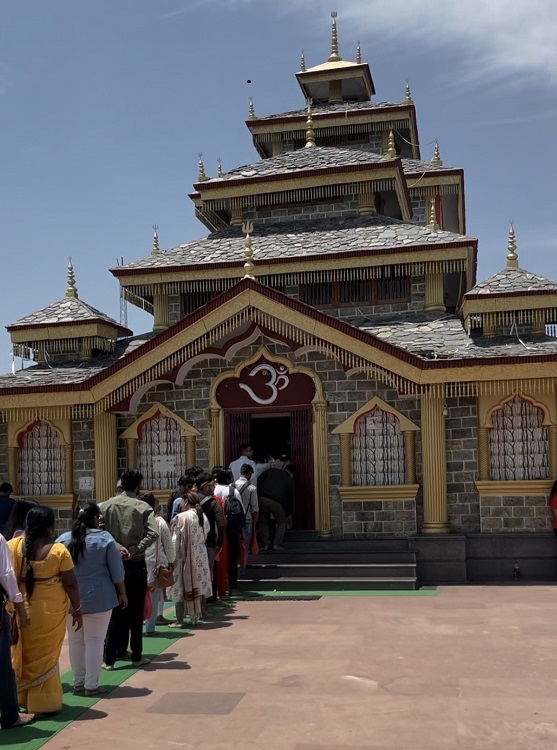Amidst the ethereal landscapes of the Tehri district in Uttarakhand, India, Surkanda Devi Temple stands as a testament to devotion and spiritual significance.
Nestled near the charming hill stations of Dhanaulti and Chamba, this ancient temple is perched at a majestic altitude of approximately 3000 meters. Here, amidst the grandeur of the Himalayas, devotees and visitors find solace and seek blessings at the sacred abode of Goddess Surkanda Devi, an incarnation of the revered Goddess Sati.
As one approaches Surkanda Devi Temple, the air tingles with otherworldly tranquility, carrying whispers of ancient legends and timeless devotion. The temple’s elevated location offers awe-inspiring panoramic views of the surrounding Himalayan peaks, where majestic snow-capped summits reach for the heavens, and verdant valleys spread out in all their splendor.
Legend and Mythology
According to ancient Hindu mythology, the origins of Surkanda Devi Temple are rooted in the tale of Goddess Sati, the first wife of Lord Shiva. It is believed that when Sati’s father, Daksha Prajapathi, organized a grand Yagna (sacrificial ceremony), he intentionally omitted to invite Sati and Lord Shiva. Filled with anguish and despair, Sati decided to attend the event uninvited, despite Lord Shiva’s warnings. In the midst of the grand event, Daksha insulted Lord Shiva, which deeply hurt Sati. Consumed by her emotions, she self-immolated in the fire of the Yagna.
In grief and fury, Lord Shiva embarked on a sorrowful journey, carrying the lifeless body of Sati. As he roamed the earth with her remains, the gods grew increasingly concerned about his destructive path. To prevent further devastation, Lord Vishnu intervened and severed the body of Sati into 51 parts using his Sudarshan Chakra (divine discus). These parts fell at various locations across the Indian subcontinent, which became sacred sites known as Shakti Peethas. Sati’s head fell at the spot where the modern Surkanda Devi temple stands today, giving the temple its name. Over time, “Sirkhanda” transformed into “Sarkunda,” and then to “Surkand” as it is known today.
Festivals and Celebrations
During the festival of Navratri, the temple premises are adorned with colorful decorations and illuminated with lights, creating a mesmerizing sight. Devotees engage in devotional singing and dancing, known as Garba and Dandiya, as they celebrate the victory of good over evil. The entire atmosphere is charged with excitement and devotion, making it an ideal time to witness the region’s rich cultural heritage and religious fervor.
During the auspicious occasion of Ganga Dashera, Surkanda Devi Temple comes alive with a vibrant and festive atmosphere. Ganga Dashera is a significant festival celebrated in the Hindu calendar, which falls on the Dashami (tenth day) of the bright half of the Hindu month Jyeshtha, usually in the month of May or June. The festival commemorates the descent of the sacred river Ganga to Earth, symbolizing purity and divine blessings.
As part of the celebrations, a grand fair is organized at Surkanda Devi Temple, attracting a multitude of devotees and visitors from far and wide. The fair is a kaleidoscope of colors, sounds, and activities, infusing the surroundings with joy and merriment. The entire temple complex is beautifully decorated, creating a festive ambiance that reflects the religious and cultural significance of the occasion.
The fair offers a diverse range of attractions and experiences for the attendees. Stalls are set up, showcasing local handicrafts, traditional clothing, and religious artifacts. Visitors can immerse themselves in the lively atmosphere, exploring the offerings of the fair, and purchasing souvenirs and mementos as tokens of their visit.
Local Legends and Folklore
Surkanda Devi Temple has been a part of local folklore and legends, passed down through generations. One popular legend narrates the story of a local shepherd boy who had a divine encounter with Goddess Surkanda Devi. It is said that the boy while grazing his sheep, encountered a goddess-like figure in the form of a young girl. The girl asked him for water, and the boy offered her his leather water bag, known as a “Surkanda.” The girl drank the water and disappeared, leaving the boy astonished. The boy later realized that he had encountered the goddess herself and built a shrine in her honor at the very spot.
This story of the shepherd boy’s encounter and the origins of the temple has become an integral part of the local folklore, strengthening the belief in the divine presence and power of Goddess Surkanda Devi.
Best Time to Visit:
Surkanda Devi Temple offers a unique experience throughout the year, each season showcasing its own charm and beauty. The months from April to October are considered the best time to visit. During this period, the weather is pleasant, allowing visitors to explore the surroundings comfortably. The clear skies offer breathtaking views of the Himalayan peaks, and the blooming flowers add splashes of color to the landscape.
Winter, from December to February, brings a different allure to Surkanda Devi Temple. The region is blanketed in snow, transforming it into a winter wonderland. The temple and its surroundings acquire a serene and mystical ambiance, creating a visual spectacle that is truly captivating. However, it is important to note that the temperature drops significantly during winter, and adequate winter clothing is essential for a comfortable visit.
Devotees have three alternatives for reaching the temple’s summit once they reach the temple’s base.
The first alternative is to hike up the well-marked stone steps, a route that tests the pilgrims’ physical endurance. The panoramic vistas become more captivating as they climb higher, creating a sense of accomplishment and fulfillment. For those who prefer a more leisurely ascent, the second option is to hire ponies, which are easily available. Riding these gentle beasts gives a sense of adventure while allowing guests to take in the natural beauty at their own speed. The third way to go to the temple is by ropeway, which allows you to effortlessly ascend to the summit and enjoy a birds-eye perspective.
#shaktipeetha in #Uttarakhand : #surkandadevi #temple: A Must #visit on this #Gangadashera on 30May,2023.
Enjoy the #ropway drive to #enjoy #TempleFestivals
Read to know more:-https://t.co/d6MNH1IQSE pic.twitter.com/cCIUVZ0XMP— jagritimedia.com (@jagriti23091982) May 28, 2023

Author
Raghvendra Singh is a passionate content writer, script writer, and a wanderer at heart. Hailing from the mesmerizing land of Uttarakhand, he finds inspiration in the breathtaking landscapes all around him. Words flow through his veins, as he crafts engaging blogs, compelling articles, and captivating social media posts.



